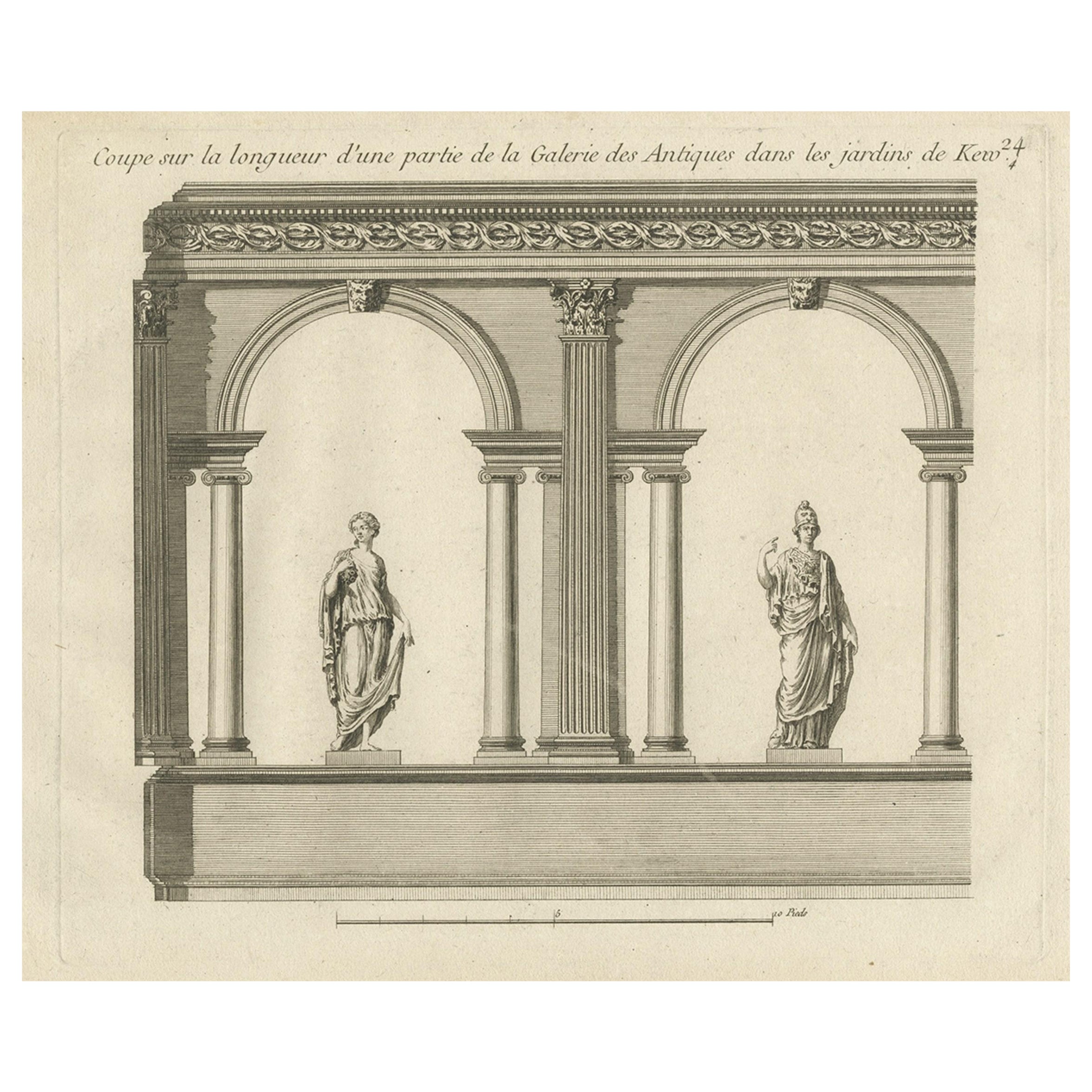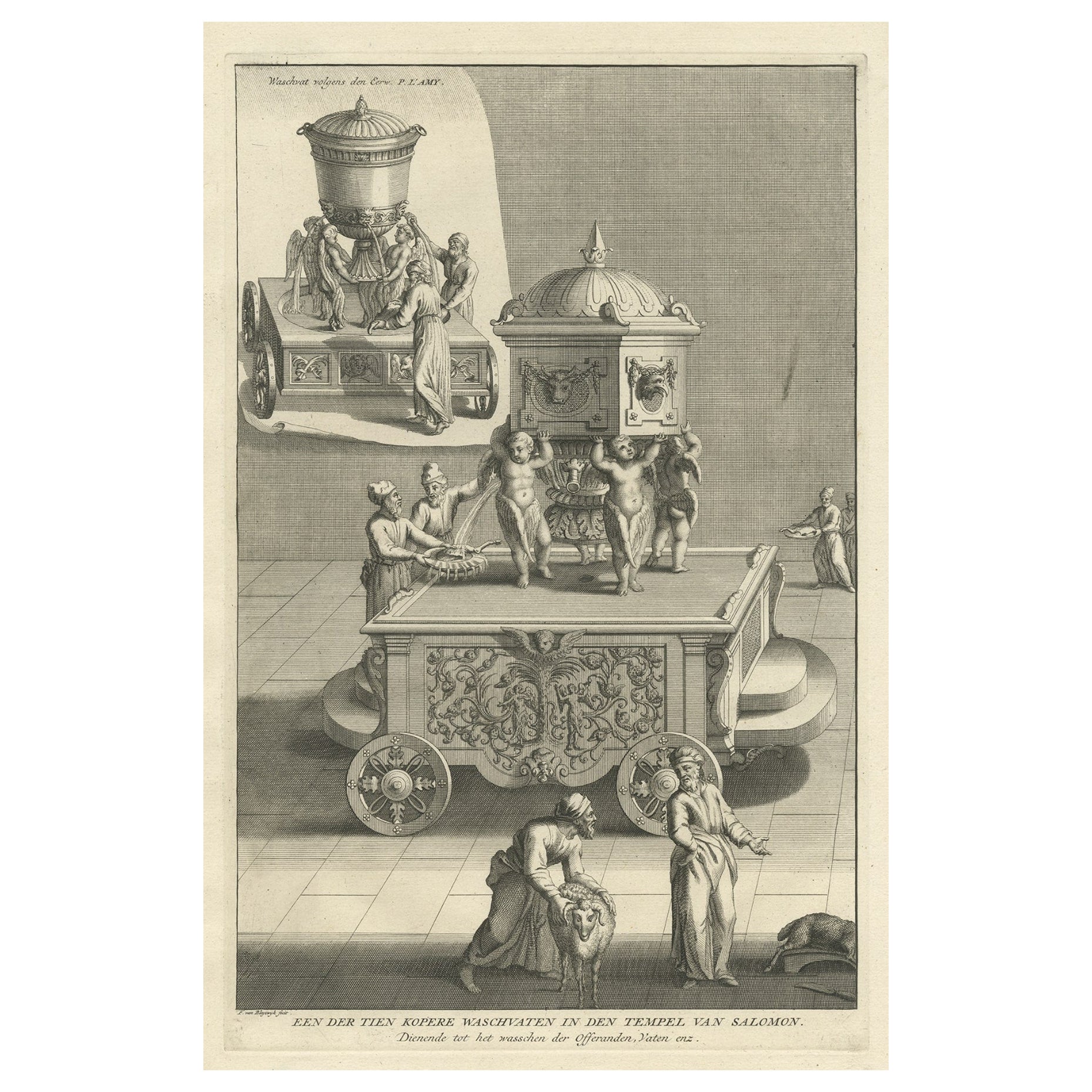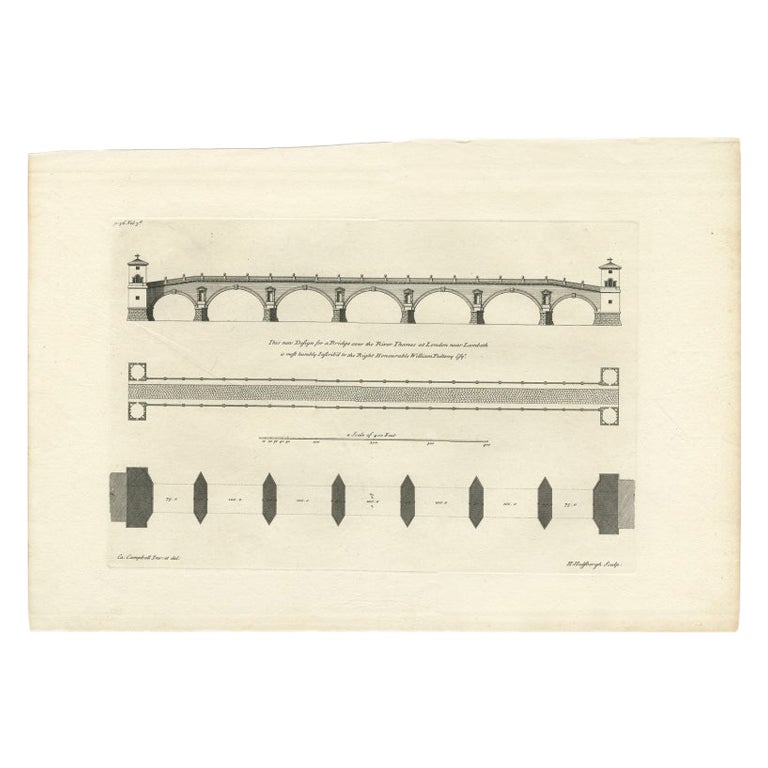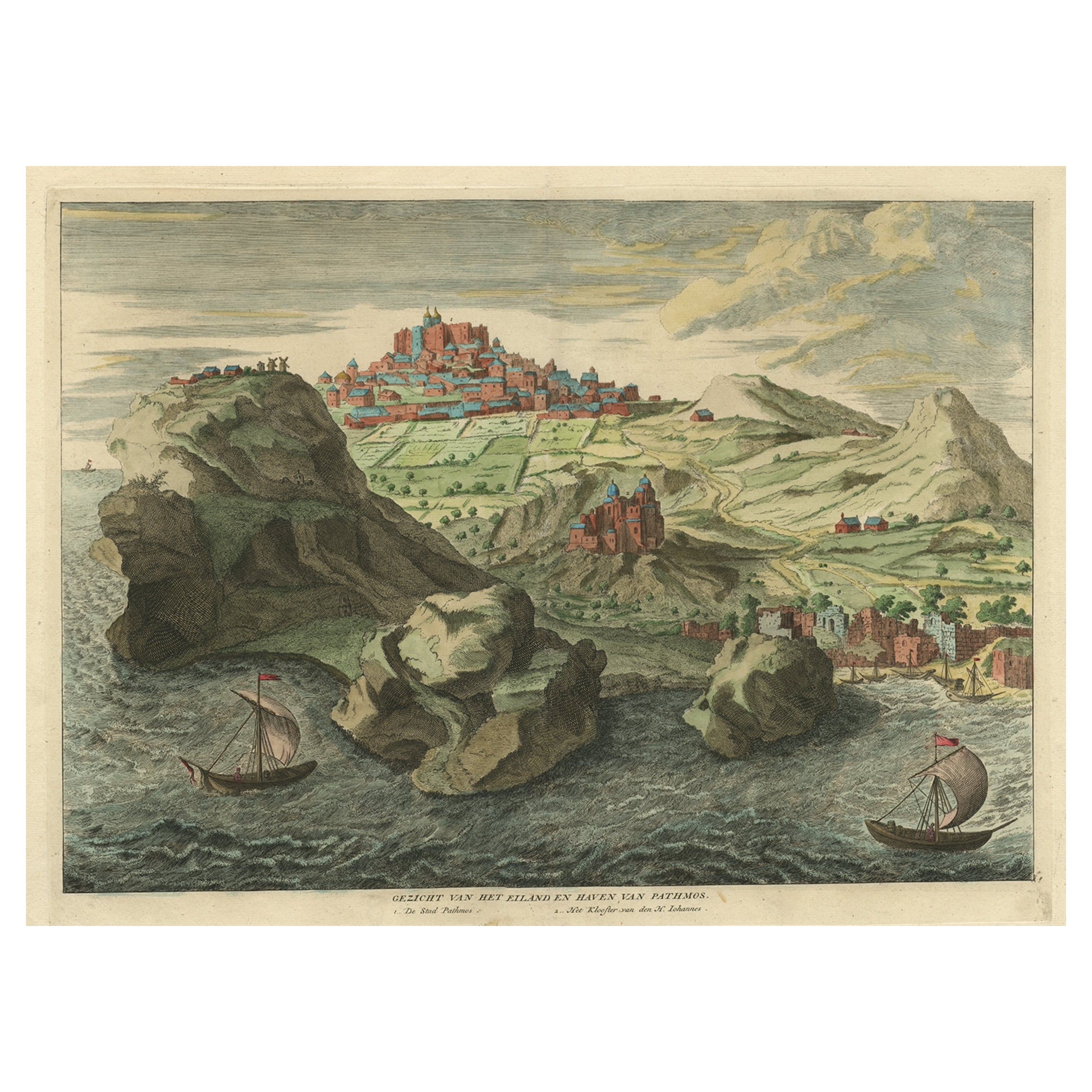Items Similar to Engraving of the Entrance Facade of the Royal Exchange, Cornhill, London, 1725
Want more images or videos?
Request additional images or videos from the seller
1 of 5
Engraving of the Entrance Facade of the Royal Exchange, Cornhill, London, 1725
About the Item
Antique print titled 'The Elevation of the Royal Exchange (..)'.
Old engraving of the entrance facade of the Royal Exchange, Cornhill. This print originates from 'Vitruvius Britannicus' by Colen Campbell.
The Royal Exchange was described by traveller Celia Fiennes in the late 17th century as ' a large space of ground enclosed round the cloisters and open arches on which are built many walkes of shopps of all trades; the middle space below was design'd and is used for the merchants to meet to concert their business and trade and bills, which is all open and on top of these piaza's are the effigies in stone of most of our Kings and queens since the Conquest, from whence this Exchange takes its name Royal' . The original Elizabethan exchange was destroyed by the Great Fire and a new baroque building, designed by City surveyor Edward Jarman, was opened in 1669. Daniel Defoe in his tour of the City of London (c.1720), noted that the Royal Exchange was 'finished and embellished in so exquisite a manner'. Although it 'cost the citizens an immense sum of money', Defoe thought it was money well spent. Jarman's Royal Exchange lasted until 1838, when it also burnt down.
Artists and Engravers: Colen Campbell's Vitruvius Britannicus is considered one of the greatest eighteenth-century English architectural works. Campbell published the first three volumes between 1715 and 1725, but the text was continued in two subsequent volumes by Woolfe and Gandon in 1767 and 1771. The work is comprised of large, finely engraved illustrations, plans, and cross sections of English country houses and parks.
Condition: Good, age-related toning. Blank verso. Minor wear, please study image carefully.
- Dimensions:Height: 20.08 in (51 cm)Width: 26.38 in (67 cm)Depth: 0 in (0.02 mm)
- Materials and Techniques:
- Period:1720-1729
- Date of Manufacture:1725
- Condition:
- Seller Location:Langweer, NL
- Reference Number:
About the Seller
5.0
Platinum Seller
These expertly vetted sellers are 1stDibs' most experienced sellers and are rated highest by our customers.
Established in 2009
1stDibs seller since 2017
1,916 sales on 1stDibs
Typical response time: <1 hour
- ShippingRetrieving quote...Ships From: Langweer, Netherlands
- Return PolicyA return for this item may be initiated within 14 days of delivery.
More From This SellerView All
- Copper Engraving of a Section of the Royal Botanic Gardens, Kew, London, 1776Located in Langweer, NLAntique print titled 'Coupe sur la longueur d'une partie de la Galerie des Antiques dans les jardins de Kew'. Copper engraving showing a section of the Royal Botanic...Category
Antique 1770s Architectural Models
MaterialsPaper
- Antique Engraving of the Brass Laver in Solomon's Temple, Jerusalem, ca.1725Located in Langweer, NLAntique religion print titled 'Het kopere Waschvat, Tusschen de Tente der t'zamenkomst en den altaar'. Antique print of the Brass Laver in Solomon's Temple. This print originates...Category
Antique 1720s Prints
MaterialsPaper
- Antique Engraving of One of the Ten Brass Lavers in Solomon's Temple, 1725Located in Langweer, NLAntique religion print titled 'Een der tien Kopere Waschvaten in den Tempel van Salomon'. This print depicts one of the ten Brass Lavers in Solomon's Temple. This print originate...Category
Antique 1720s Prints
MaterialsPaper
- Antique Print of a Design for a Bridge across the Thames, London, England, 1725Located in Langweer, NLAntique print titled 'This new Design for a Bridge over the River Thames at London (..)'. Print of the design for a new bridge across the Thames at Westminster. This print originates...Category
Antique 18th Century Prints
MaterialsPaper
- Antique Print of London with St. Paul's Cathedral Before the Fire, ca.1725Located in Langweer, NLAntique print London titled 'Londres, capitale de l'Angleterre'. Antique print of London with St. Paul's Cathedral (before the fire) in the...Category
Antique 1720s Prints
MaterialsPaper
- Old Engraving the City and Harbour of Pathmos, Patmos or Patimo in Greece, 1725Located in Langweer, NLAntique print, titled: 'Gezicht van het eiland en de haven van Pathmos (…).' This plate shows a view of the city and harbour of Pathmos, Patmos or Patimo in Greece. This plate or...Category
Antique 1720s Maps
MaterialsPaper
You May Also Like
- “The Restaurant of the House of Representatives” Engraving by Harper's WeeklyLocated in Colorado Springs, COThis original wood engraving is titled “The Restaurant of the House of Representatives, Washington, DC.” It was published as a double-page image, in the August 12, 1893 issue of the famous 19th century newspaper Harper’s Weekly. The print was illustrated by Charles Stanley Reinhardt. The House Restaurant, a unique part of life in the Capitol, has been in the same location since the 1857 Capitol Expansion. Congressional members’ busy work schedule made the availability of food on site a necessity. But the restaurant also served as an informal meeting spot for members to continue conversations and deal making. This 1893 print illustrates the convivial atmosphere. Details including elegantly dressed tables...Category
Antique 1890s American Prints
MaterialsPaper
- 1876 "Gettysburg, The Repulse of Longstreet's Assault." EngravingLocated in Colorado Springs, COPresented here is an 1876 engraving of John B. Bachelder and James Walker’s Gettysburg. The Repulse of Longstreet’s Assault. The engraved scene depicts the decisive battle on the final day of the Battle of Gettysburg. Researched by the photographer and topographer John B. Bachelder and painted by James Walker, the original painting was created in 1870. This detailed engraving was done by H. B. Hall Jr. and published by James Drummond Ball. Otherwise called Pickett’s Charge, the battle occurred on July 3, 1863. Pickett’s corp commander, Lieutenant General James Longstreet was placed in charge of the attack despite his hesitations. Longstreet’s central role led to the title of the work, Repulse of Longstreet’s Assault. In an attempt to gain control of an important supply route, nine Confederate brigades charged across three-quarters of a mile of open ground against cannon fire to take Cemetery Ridge from the defending Union Army. Despite their overwhelming numbers, the Confederate forces were repelled with considerable casualties marking not only a decisive victory for the Union, but also the beginning of the slow defeat of Lee’s Army. The furthest the charging forces advanced before being repulsed would forever be known as the “High Water Mark of the Confederacy.” The Confederate army never recovered from the losses at Gettysburg and it effectively ended Lee’s campaign into Pennsylvania. The engraving gives the perspective from the Union rear, one that encompasses most of the battlefield, from Big Round Top on the left to the northern reaches of Cemetery Ridge on the right. The Confederate lines at Seminary Ridge are in the far distance, partially obscured by bursting shells. The image centers on the main Confederate assault, in the vicinity of what today are known as "The Copse" and "The Bloody Angle." The composition has elemen...Category
Antique 1870s American Prints
MaterialsPaper
- Set of Twelve Colored Engravings of the Defeat of the Spanish Armada by J. PineLocated in Essex, MABy John Pine considered the foremost heraldic and decorative engraver of his generation. Depicting the defeat of the Spanish by the English Fleet in 1588. These are after a set of tapestries that hung in the House of Commons...Category
Antique 1740s English Prints
MaterialsPaper
- Sarah Porter, "Queen of the Touters at Tunbridge Wells" Engraving, circa 1770Located in Lowestoft, GBAfter Vander Smissen 'Mrs Sarah Porter, Queen of the Touters at Tunbridge Wells', a mezzotint, engraved by William Pether circa 1770, glazed in ebonised, ...Category
Antique Late 18th Century English Prints
MaterialsGlass, Pine, Paper
- Engraving Print from the Panckoucke Encyclopédie Nautical Subject 1782-1832Located in Milan, ITPrint by engraving on copper plate from the Panckoucke Encyclopédie méthodique, end of the 18th century, volume Marine Planches (more than 1,500 figures dealing with all subjects on ...Category
Antique 1790s French Nautical Objects
MaterialsPaper
- Engraving Print from the Panckoucke Encyclopédie Nautical Subject 1782-1832Located in Milan, ITPrint by engraving on copper plate from the Panckoucke Encyclopédie méthodique, end of the 18th century,volume Marine Planches (more than 1,500 figures dealing with all subjects on the marina: planes, construction, carpentry, tree trunks, armaments of maneuvers, ropes, sails, artillery, ship maneuvers and combat tactics). This is the plate no. n. 24, pag. 69 fig. 341 ; with frame cm 38.3 x 31.5. Ship ropes are depicted. The Print has the "Benard direxit...Category
Antique 1790s French Nautical Objects
MaterialsPaper
Recently Viewed
View AllMore Ways To Browse
Architectural Studies
Architectural Study
House Model
Model Of House
Space Age Architecture
London Images
Antique Facade
Used Furniture Exchange
Antique Building Facade
Architectural Model House
Antique English Models
Model Arch
Architecture Building Model
Antique English Architectural
Architectural English Antique
Antique House Architectural Design
Architectural Design Of Antique House
English Architecture Prints





